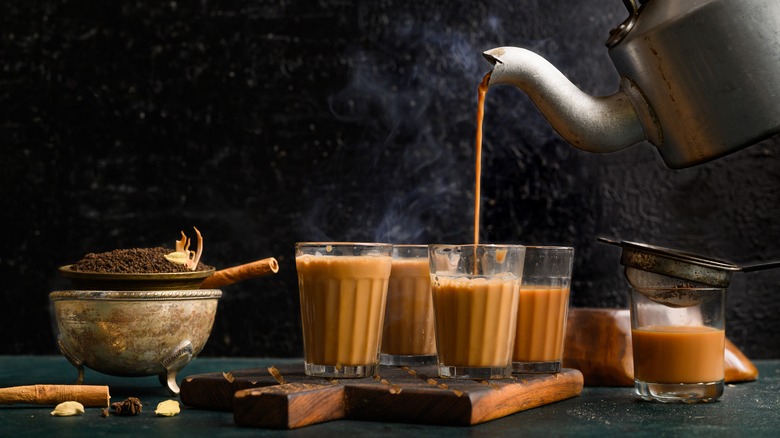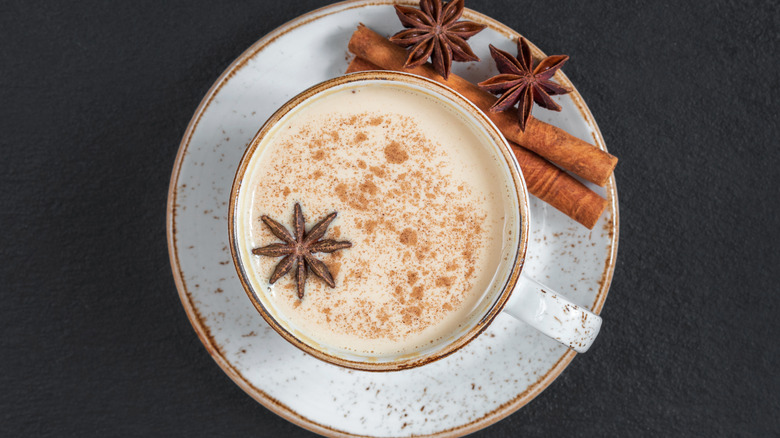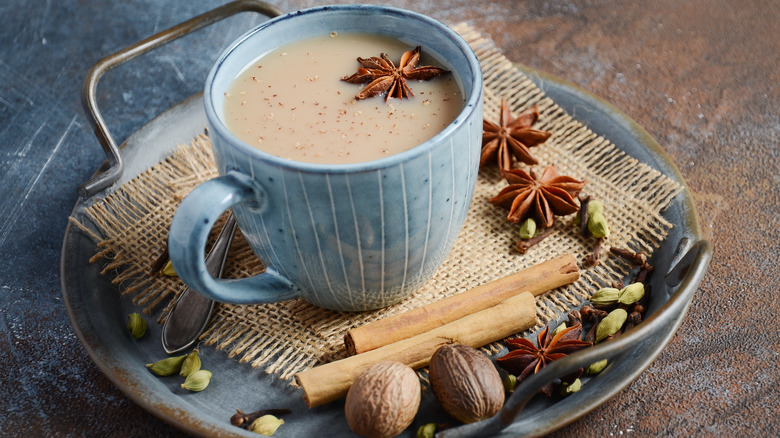The Medicinal Origins Of Chai (And Why It Didn't First Include Tea Leaves)
First popularized in America by blockbuster coffee chain Starbucks, masala chai is a very beloved yet massively misunderstood drink. For one thing, calling it chai tea is redundant, as chai means tea. Instead, opt for calling it masala chai or masala tea, as what makes this beverage special is the masala, or spice, part. For another, no two masala spice blends are the same, as each region of India has its own personal take on the cult classic beverage, so there's no definitive recipe.
With all this confusion surrounding the drink, it comes as no surprise that its origins are equally mysterious to the average consumer. The historical backstory for the first masala-spiked drink goes back thousands of years and involves ancient medicinal beliefs and Indian kings. Most interestingly of all? There was no tea to be had in these early masala beverages. So how did this mainstream favorite begin as a cure-all tonic?
Masala chai was heavily influenced by spices
Much of India's ancient understanding of the medical world was through Ayurveda, the Sanskrit term for "the science of life." This scientific discipline was predominantly informed by the Vedas, holy scripture from the Vedic religion that contained hymns, ritual procedures, and philosophy. One of the leading principles of Ayurveda was that proper digestion led to overall good health. Thus many ayurvedic drinks, punctuated with herbs and spices, were designed to aid in digestion. It is from this class of medicinal beverage that masala chai hails.
Nearly 5,000 years ago, Indian emperors were known to drink a heavily spiced concoction to keep them refreshed during long periods at court. Despite the kings using this masala drink as a pick-me-up, these early incarnations contained no tea and were actually caffeine-free. The emphasis was on the spices used, with each assigned a health property according to Ayurveda.
The ginger and black peppercorns were to aid digestion, while the cardamom boosted the drinker's mood, and the cloves helped numb any pain. Cinnamon, too, was believed to help respiration and circulation. Even star anise was included in order to freshen one's breath. This elixir would spread to numerous parts of India, with each place creating its own signature blend of spices but maintaining its reputation as a popular restorative cure. So when did this spicy tonic become the milky, sweet, and caffeinated beverage we know today?
Masala chai as a quiet rebellion of colonial rule
By the 19th century, Britain had much of India in a chokehold of colonial rule, using vast swaths of land to farm their beloved Assam and Darjeeling tea. Unlike the Chinese, the Indians did not have an ancient love for tea, and it was a beverage that held little interest for the average citizen. Still looking to exploit the large market in India, British companies tried to incentivize the tea experience, building numerous tea stalls and offering scheduled "tea breaks" for workers at their factories. The Indian public was resistant at first, as tea was still an extremely expensive beverage, but they quickly found a way to work around this issue.
They'd dilute the tea with less costly yet extremely flavorful spices, sugar, and milk. Here's where the historic masala drink transformed into its modern version, as Indians began using their classic masala spices to accent the bitter tea. In a subtle form of rebellion, the Indian populace had made masala chai their own cheaper and more flavorful drink.
Masala chai is still considered to have several health benefits, from the antioxidant qualities of cardamom and black tea to cinnamon's possible aid in lowering blood pressure (via How Stuff Works). With that in mind, the next time you enjoy a cup of masala chai, you can take comfort in the knowledge that you're literally drinking to your health.


